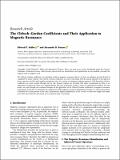The Clebsch–Gordan Coefficients and Their Application to Magnetic Resonance
Author(s)
Saliba, Edward P.; Barnes, Alexander B.
DownloadCMRA.2022.1143341.pdf (1.365Mb)
Terms of use
Metadata
Show full item recordAbstract
The Clebsch–Gordan coefficients are extremely useful in magnetic resonance theory, yet have an infamous perceived level of complexity by many students. The Clebsch–Gordan coefficients are used to determine both the matrix elements of the spherical tensor operators and the total angular momentum states of a system of component angular momenta. Full derivations of these coefficients are rarely worked through step by step. Instead, students are provided with tables accompanied by little or no explanation of where the values in it originated from. This lack of direction is often a source of confusion for students. For this reason, we work through two common examples of the application of the Clebsch–Gordan coefficients to magnetic resonance experiments. In the first, we determine the components of the magnetic resonance Hamiltonian of ranks 0, 1, and 2 and use these to identify the secular portion of the static, heteronuclear dipolar Hamiltonian. In the second, we derive the singlet and triplet states that arise from the interaction of two identical spin- particles.
Date issued
2022-05-17Department
Francis Bitter Magnet Laboratory (Massachusetts Institute of Technology)Publisher
Hindawi
Citation
Edward P. Saliba and Alexander B. Barnes, “The Clebsch–Gordan Coefficients and Their Application to Magnetic Resonance,” Concepts in Magnetic Resonance Part A, Bridging Education and Research, vol. 2022, Article ID 1143341, 18 pages, 2022. doi:10.1155/2022/1143341
Collections
The following license files are associated with this item: